From 27 February to 17 March 2017, Aoife van Linden Tol, a multimedia artist working primarily with explosive media who is the recipient of the first art&science@ESA residency, organised by Ars Electronica in partnership with ESA, was a special guest at the European Space Research and Technology Centre (ESTEC) in Noordwijk, The Netherlands, for the first part of her residency.
We asked Aoife to share her thoughts at the end of these three intense weeks spent talking to ESA scientists, and to tell us about her plans and expectations for the second part of the residency and the resulting artwork. Aoife will be back at ESTEC for another three-week stint at the end of April.
Q: How was your experience at ESTEC and did it live up to your expectations?
A: It was wonderful! I enjoyed being here so much, I felt very at home and didn’t really want to leave! The residency was very broad and I managed to do pretty much all that I expected.
I had planned to be very open, not too focussed on specific details, to learn about the research that people do here.
I tried to soak up as much as possible, from the physics of the Sun to the formation, evolution and explosion of stars; from the study of distant galaxies to cosmology and the fundamental physics of gravity. I learnt about light production within stars, how particles travel through space, how we measure all these phenomena, and how we build a picture of what is actually happening.
I have to admit I felt like the first week was very slow, I didn’t feel much progress… but then later I realised that I did so much: I looked at the Sun through a telescope (editor’s note: with a proper filter!) for the first time, organised my schedule, attended meetings and several lectures, wrote an abstract for a proposed paper, and began sketching. The next two weeks were even more intense! Now I am a little overwhelmed and tired after three weeks, which is a very good sign: it means the neural pathways in my brain are starting to work hard and make all the right connections. I learnt so much during my time here, and now it’s a good moment to go back and process everything.

Left image: Space educator Jolanda Preusterink looking at the Sun through a telescope with a special filter at ESTEC; central images: Aoife projecting the view of the Sun through the telescope on a sheet of paper; right image: Jolanda observing the Sun with Dr Bernard Foing. Courtesy A. van Linden Tol.
Q: How did you interact with the scientists at ESTEC?
A: I arranged individual appointments, talking to each scientist for about an hour. I asked them to explain to me, in painstaking detail, what they do. I preferred to start this way at this stage because asking specific questions seemed to narrow the conversation to very generic subjects which were not necessarily their area of expertise anyway.

Dr Jack Carlyle showing Aoife how to use JHelioviewer, a visualisation software for solar image data. Courtesy A. van Linden Tol.
Each scientist knows their own research inside out and it is often so specific that other scientists don’t know each other’s work in depth. I found I could probe much deeper, expand my understanding more, and have more fun simply allowing them to talk about what they know best. So we covered favourite topics, interesting anomalies or experiences, funny stories, details about what data sets they worked with and how they worked on data etc. with a general leaning toward the Sun and the stars.

One of the whiteboards in Aoife’s office, with notes and sketches taken while discussing with Dr Victoria Grinberg, who studies X-ray binary stars. Courtesy A. van Linden Tol.
Now that I have an overview, specific questions will come later. I talked to well over 25 people but unfortunately I could not meet everybody and I still have some appointments for my return to look forward to, but I managed to speak to almost all scientists who do research about stars and the Sun, which will be the thematic focus of the artwork.
I loved the 10am coffee rendezvous, an informal meeting that takes place every day in a room that is nicknamed the ‘wormhole’, where scientists from ESA’s Science Support Office meet and chat. It was great to get introduced to everyone, get to know people better, and meet the support team. I ended up on several impromptu adventures in restricted areas around the building because I happened to meet the right person at the right time there!
Q: How did the scientists react to your presence?
A: They were all very open and curious to hear about my art practice and the project. They were very enthusiastic and patient with my questions! I know some are interested to participate more directly in the work if possible, but we didn’t talk too much about my work this time, we mostly focussed more on the science, on me learning what they do. However, there were also some interesting conversations about the similarities between art and science, as well as the ethics of space colonisation and the politics of space research.
Q: Did you get to visit any special facility?
A: Yes, I had a tour of the test centre where spacecraft are tested for the extreme conditions they will encounter in space. I also visited the mechanical laboratory, and the materials and electrical components laboratory. All those areas are restricted so there are no photos to show unfortunately but it was fantastic to see the most weird and wonderful machines. I even had a tour of the room hosting the computer servers, to have an idea of how data are stored and shared across the world. Some of the scientists were surprised I was interested in such “boring” things!
During this visit I had a chance to attend the EuroMoonMars Village workshop, a multi-disciplinary meeting held in ESTEC to discuss sustainable and sociological approaches to human and robotic exploration of the Solar System. I made a preliminary design for the Moon Village concept after a discussion with Dr Bernard Foing about the possible options for protecting astronauts against radiation.
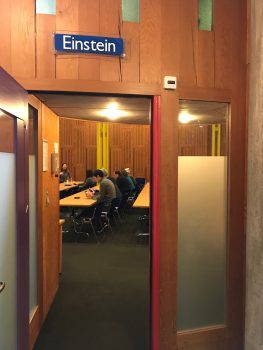
The Einstein meeting room at ESTEC, where most of the colloquia take place. Courtesy A. van Linden Tol.
The design, with a working title of Sky Lake, involves building a closed lake at least 2.5 meters deep, above craters or caves, supported by a suspension structure and sectioned into different areas. From below it looks like a sky of water, from above it looks like a lake of water. The design would allow free movement without space suits below the water level, and water sterilisation and purification within the system. It includes a bio-diverse ‘habiton’, protects from radiation, and even has the ability to make it rain!
So much happens here at ESTEC! I met so many people, even some that don’t work here but were visiting for one reason or another.

Dr Mark Price giving a colloquium talk about high-velocity impacts in the Solar System. Courtesy A. van Linden Tol.
For example at the weekly colloquia, which were extremely interesting, one of the speakers was Dr Mark Price from the University of Kent, UK. He studies hypervelocity impacts in the Solar System using the University’s Light Gas Gun facility to emulate high velocity impacts (up to 8 km/s) with a range of projectiles and targets that represent the range of surfaces found in the Solar System. Surprisingly, this is quite close to some experiments I perform in my artistic practice: even the materials we use are similar, and I have arranged to visit the impact facility at the University of Kent once I’m back in the UK.
It was great to meet other artists during my stay including musician Nick Roth, who was visiting the facilities to research for an incredible interactive immersive education project for The Ark in Dublin, which will teach children about space. I also met Pepa Ivanova who is collecting her own data from the Sun in order to make sonic compositions, as well as various science educators, science-art collaborators, geologists, and water engineers.
Q: How did your creative process work during this part of the residency?
A: When I arrived, I had some intuitions about what the physical manifestation of the Star Storm concept might look like – a series of explosive performances inspired by the physics of stars. The overall arc of the performance wasn’t completely set in stone though: I left it free to evolve during the residency, and now it is starting to come together. I am hoping I will be able to set it up the way I am starting to imagine it at the Ars Electronica Festival in September, and that the team at Futurelab will be up to the challenge!
But right now I really need to go back to my studio, as it can be difficult to work on developing the performance of the work while still immersing your mind in new information. The time here is precious to me and I felt the best use of it was to learn as much as possible.
Like scientific research, my artistic work is a bit of a balancing act between chaos and order.
I had the intuition to include a moment of chaos into the performance while having a Skype meeting with Dr Bernhard Fleck, ESA Project Scientist for the Solar and Heliospheric Observatory (SOHO) who is based at NASA’s Goddard Space Flight Center in the USA. He was explaining to me how a certain technique in the context of helioseismology, which became hugely popular in the 1990s, does not really work as expected due to the magnetic field having a much stronger effect than previously calculated. Scientists are still investigating the technique, however it throws a lot of previous findings out of kilter. I really felt the sense of loss and gain, clarity and chaos. To be an astronomer you need to accept the game of cat and mouse with the cosmos. It’s part of the natural process of discovery.
Even with the explosives I work with there is a hidden order which reveals itself when used in particular ways, and it’s all about being able to see this underlying, mathematical order. The same applies to the methodologies used in scientific research. It was very important for me to ask the scientists about how the data they use were measured for their specific field of research. For example, which data sets they chose to use, from which instruments, on which spacecraft or ground-based observatories, and why. The answers to these questions reveal much about the nature of the subject matter, its local environment, what is happening between the subject and the observation point. The phenomenon discovered about the Universe is, of course, inherently tied to the way it is measured, so it is fascinating to understand this process.
Q: Did you make any artwork while at ESTEC?

One of the sketches made by Aoife during her residency at ESTEC, suggestive of a series of spectral lines. Courtesy A. van Linden Tol.
A: I made some abstract sketches, throwing pigments and charcoal powder as well as using elastic bands and pins to experiment with emulating magnetic pathways carrying plasma. This was helpful for putting on paper some ideas I had during conversations with the scientists. For example, I made one sketch that brings to mind a series of spectroscopic absorption lines, but for me it also symbolizes information passing through, or how there is always something we cannot see: our lack of information and the need to infer results indirectly. This goes back to the balancing act between chaos and order that I mentioned earlier.
It’s fascinating how the instruments used and even the wavelength at which scientists observe a particular phenomenon are very specific to the physical questions they’re trying to address. I learnt that with X-ray observations, most of the time you need something to happen, like gas accreting onto a compact object or a star exploding as a supernova. Or, how you can’t see the lines of a magnetic field directly, but you can infer their structure from the way particles behave in a certain cosmic environment. Similarly, for distant galaxies, you measure spectra of their star light, then fit them to a model and estimate the properties, distance and evolutionary stage of the host galaxy, but there is a lot of inference, and the error margin can be negligible or hugely significant depending on the technique.
As these abstract ideas manifest visually into sketches, they are already beginning to incorporate a lot of the inspiration of the piece, and eventually they might develop into more specific and calculated aspects of the final performance.
 |
 |
 |
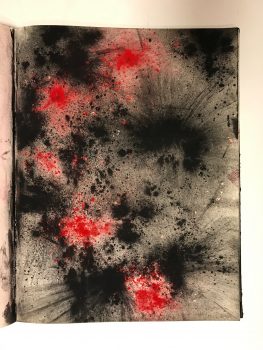 |
| Sketches made by Aoife during her residency at ESTEC. Courtesy A. van Linden Tol. | |
|---|---|
Q: What are you planning to do in the second part of the residency?
A: After the introductory visit to ESTEC last November and these recent three weeks, I now have material to develop the individual performance concepts and the overall performance arc. I will work on that in my studio in London and will come back with much more specific questions and requests for exact data regarding the specific phenomena I choose to use as inspiration. I will work with the scientists on the details, adding more layers to the performance to make sure that the piece is relevant to the scientific questions they are investigating.
In the next phase of the residency I will initiate and realise an interactive artwork with the aim of engaging people in discussion. I will also offer a workshop which I am now developing that will provide participants with a peek into my artistic research process and hopefully allow us to collaborate on a mini project. Now that I have a feel for what most of them do and how they think and work, I can gauge better where the meeting of our art and science practices can collide and make something happen!
 |
 |
 |
 |
| Aoife working on sketches in her office at ESTEC. Credit: ESA/C. Carreau, CC BY-SA 3.0 IGO. | |
|---|---|
Q: Have your thoughts about art and science evolved during this first part of the residency?
A: I am really curious to understand more about what artists can do to influence science in terms of creative and critical thinking. We didn’t discuss much about this in terms of the Star Storm project itself because it is only just starting and so I was focussing on the science and on learning what everyone is working on, and this was already quite intense – I definitely feel that my knowledge was challenged a few times!
I did have a chance to talk to some of the scientists about what they think, for example, about the future of humans in space, and they do have very contrasting opinions: some are confident that we’ll be living on the Moon or Mars in a few decades, which brought up lots of ethical debates, while others are convinced it will never happen and is not worth thinking about just now.
I, and a growing number of arts and science practitioners, believe that artists have an enormous potential not only to help scientists in outreach activities and inspiring the next generations with the beauty of space and science, but also to use the critical thinking skills to approach questions about space culture, economic, social and legal structures, and to frame them in a broader context: what do we choose to do with our tools, whether they be art, education, science, or space exploration? We need to find ways not just to ask questions but to look for answers to those questions and even to help instigate the changes that our societies may need to implement in order to deal with such profound events. The belief that we can live on other planets is important in driving forward the search for answers. The answers we find now could be incredibly useful to us here on Earth, whether or not we actually make it to other worlds in the future.
Perhaps these fundamental questions will play a role in the overall arc of the Star Storm performance, adding a human level to the piece, while the individual details will focus on aspects of scientific research. But now it’s too soon to tell…

A rainbow on the walk from Noordwijk to ESTEC on the first day of Aoife’s residency. Courtesy A. van Linden Tol.
The full collection of photos from Aoife’s residency at ESTEC is available on the ESA Events Flick-r.

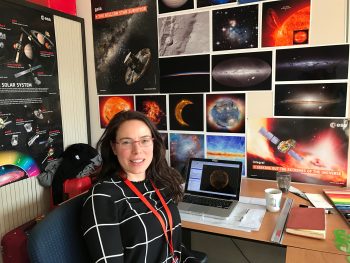

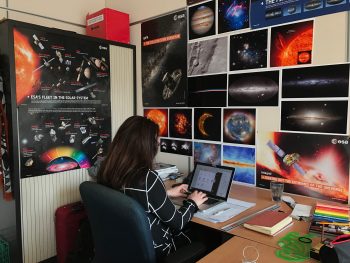

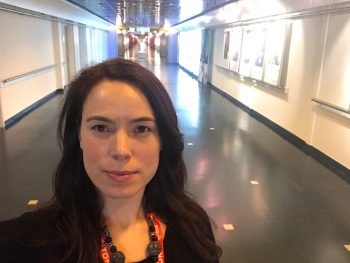



Discussion: one comment
Je ne suis qu’un petit observateur Amateur … de tres belles images et intéresant a voir … Les avancées de la cience spaciale , sont tres longues et surtout lointaine ! Cela m’informe beaucoup sur les avancées … Merci